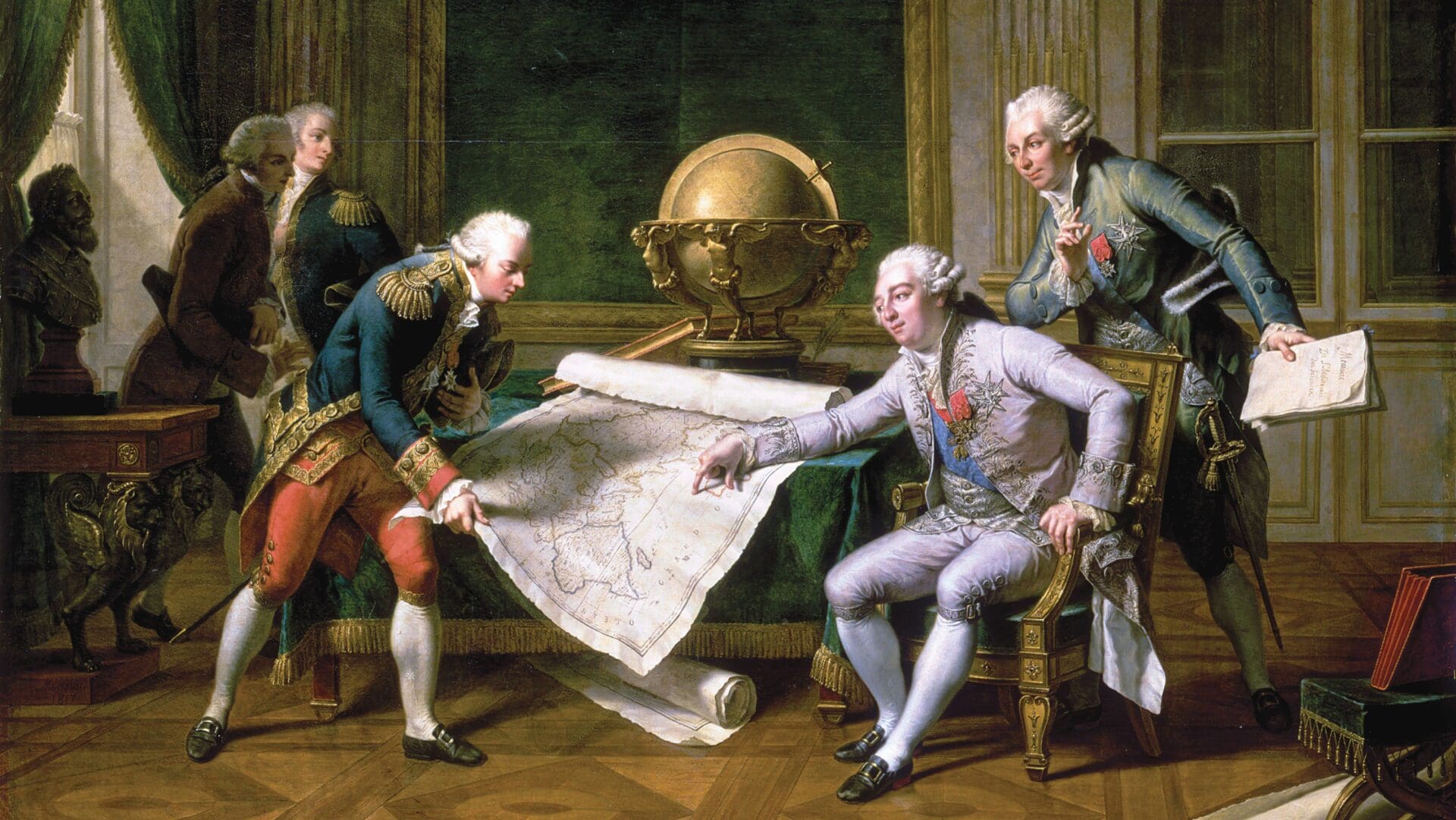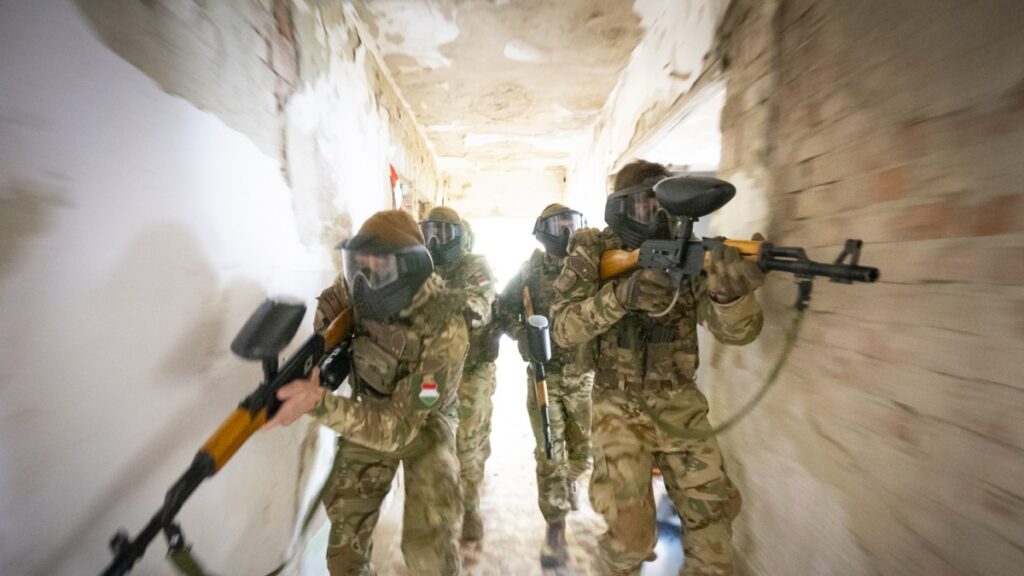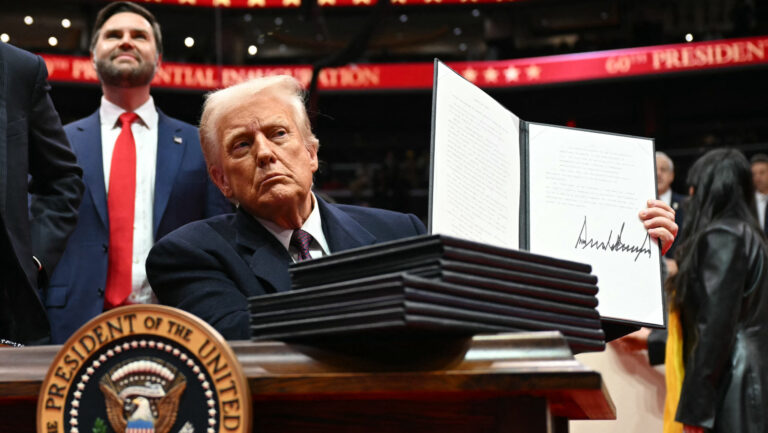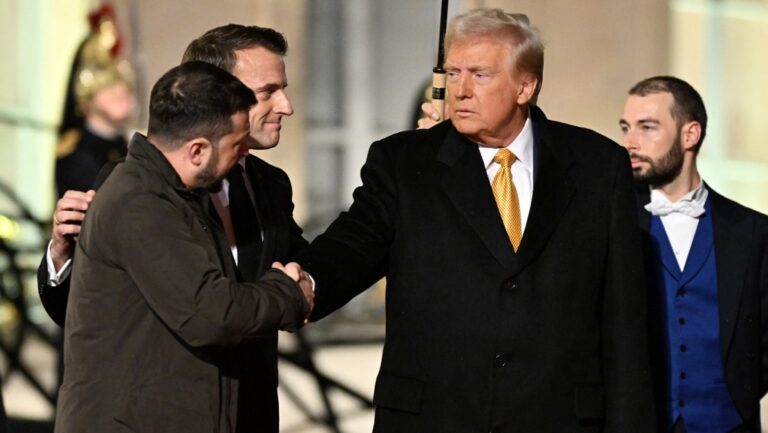This article was published in Vol. 4 No. 1 of our print edition.
In a seminal article published in mid-2014, Walter Russell Mead proclaimed the ‘Return of Geopolitics’. Mead’s contention was that Russia’s seizure of Crimea earlier in the year, along with China’s assertive claims in the South China Sea and Iran’s political manoeuvring in the Middle East heralded the ‘Revenge of the Revisionist Powers’.1 Moreover, he argued, the United States and European states had, since the end of the Cold War, distracted themselves from ‘old fashioned power plays’ by an idealistic agenda that emphasized trade liberalization, universal human rights, nuclear non-proliferation, and climate change. Believing that the ‘rules of the game’ had changed, Western nations felt they could ‘move past geopolitical questions of territory and military power’ and towards issues of ‘world order and global governance’.2
Ignoring the old rules of international politics, however, meant Western powers were vulnerable to being taken by surprise. ‘To be dragged back into old-school contests such as that in Ukraine’, Mead noted, did not just divert time and energy away from the West’s idealistic preoccupations ‘but it also changes the character of international politics’. Mead’s point, of course, was that the fundamental realities of international relations had not changed, but that Western nations had merely misread the realities, mistaking the ‘ideological triumph of liberal capitalist democracy over communism’ for the ‘obsolescence of hard power’.3
After 2014, the dawning realization that the West was being led into a new era of ‘great-power competition’ by the revisionist powers4 resulted in a renewed interest in geopolitics and, especially in the notion of ‘grand strategy’. Grand strategy represents a commitment to a national vision where the key elements of power—economic, military, and social—are coordinated to sustain the values and commitments that uphold the vision over the long term.5 Adherence to a coherent and well-formulated grand strategy on the part of powers like China and Russia placed the West at a disadvantage. From the 2010s onward, books, articles, and centres of study sprouted, seeking to rehabilitate the idea of grand strategy as a way of reviving Western understandings of the realities of geopolitics.6
Russia’s invasion of Ukraine in February 2022 heightened the sense that Western nations required an effective plan that would unify political and military efforts to counter Russian irredentism. In the words of Anthony Cordesman, ‘optimistic rhetoric is no substitute for grand strategic realism’. Western powers, according to Cordesman, ‘need to determine what grand strategy they should pursue to shape the longer-term course of the war and its lasting outcome’.7
‘The world is confronted by an “axis of autocracy” comprising Russia, China, and its supporters […] and an “axis of democracy” represented by the US and its various allies’
The felt need for a grand strategic endeavour to unite the West and return it to geopolitical sentience was necessary not only to take on Russia, but also Russia’s chief backer, China, whose hegemonic ambitions were also of increasing concern, especially in the region known as the Indo-Pacific—the broad expanse of Eurasia extending eastward from Russia towards China and the Pacific littoral in North and Southeast Asia.8
The course of this article, then, seeks to dissect the question of how the war in Ukraine has affected the return of grand strategy in the Indo-Pacific. The key contention is, echoing Mead, that grand strategy and geopolitics never really went away in the region. The Russia–Ukraine War has, however, brought pre-existing geopolitical tensions to the surface and re-presented them in sharper and more aggravated forms in ways that presage serious fault lines in the regional and global order.
The West’s Grand Strategic Plan
If it is true to claim that geopolitics departed the scene after the end of the Cold War, it is only to the extent that a realistic understanding of geopolitics went away. After 1990, global idealists—a strange collocation of neo-conservatives, neo-liberals, international ethicists, and post-national cosmopolitans—captured the commanding heights of US and Western foreign policymaking. Viewing the world as it ought to be, it was they who believed that the world was embarked on a liberal-democratic end of history.
Idealistic though this vision was, in many respects, it has represented the ‘grand strategy’ of the West for some three decades. This grand strategic vision holds that Western forces should intervene—militarily if necessary—in countries to re-mould regions towards a ‘rules-based’ liberal international order that, coincidentally or not, broadly aligns with US economic and security interests. We can see this grand strategy manifesting all the way from the Gulf War of 1990–1991 to eject Iraq from Kuwait, various humanitarian interventions, notably in the Balkans in the 1990s, through to the interventions in Afghanistan, Iraq, Libya, and Syria.
Arguably, this grand strategy was also realized with NATO’s eastward expansion since the end of the Cold War. This reached its crescendo—or its denouement—with Russia’s invasion of Ukraine, which, several scholars plausibly maintain, was provoked by NATO’s eastward expansion, something that even NATO officials now admit.9 We can debate whether this policy has been prudent or wise, but the pursuit of a liberal international order undoubtedly exemplifies a ‘grand strategic’ enterprise on the part of the West.
Axis of Autocracy vs. Axis of Democracy?
So, the question this article seeks to address is, after the invasion of Ukraine, what has been the geopolitical fallout for countries on the periphery of this conflict in the Indo-Pacific? To state the obvious, the consequence of the Russia–Ukraine War is that it has forced a great-power dividing line between the overt supporters of Russia, and its chief backer, China, and the supporters of Ukraine, behind which stands the US and the West more generally.
The reaction of the US to Russia’s invasion has been that states need to choose between freedom and tyranny. Either back Ukraine or be condemned. This stance was expressed in President Joe Biden’s Warsaw speech on 26 March 2022, when he declared that ‘democracies must unite in a fight against autocracy’.10 In other words, it was time to pick a side: were you with Putin and China or with the people of Ukraine and the struggle for democracy and national sovereignty?
Such appeals play out in the Indo-Pacific largely as a proxy for China’s great power aspirations, in particular the degree to which China might wish to forcibly reclaim Taiwan in the way that Russia has attempted to assert itself over Ukraine, and the broader extent to which China is seeking to strong-arm its way to regional dominance by quashing democracy in Hong Kong, oppressing its minority populations, forcefully pressing its claims in the South China Sea, and extending its quasi-imperial reach through the Belt and Road Initiative.
The fact that China supports Russia in the conflict suggests—if we are to employ Biden’s ideological lens—that the world is confronted by an ‘axis of autocracy’11 comprising Russia, China, and its supporters on the one hand and an ‘axis of democracy’ represented by the US and its various allies, most notably, in the Indo-Pacific, Japan and Australia, on the other.12
Existing in Geopolitical Ambiguity
For powers that are not formally allied to, or affiliated with, either of these axes, the geopolitical challenges are complex. What we see in the Indo-Pacific arena are degrees of alignment, where countries exist in a condition of geopolitical ambiguity, with nations either leaning towards or away from these axes, depending largely on their geostrategic position, but also on political traditions, history, and perceived national interests. Those Indo-Pacific nations that are not necessarily connected by formal arrangements with either axis tend to associate by degrees with one side or the other.
The countries of Central Asia most obviously lean towards the ‘axis of autocracy’ and away from the axis led by the US and NATO. These states, Kazakhstan, Kyrgyzstan, Uzbekistan, Tajikistan, and Turkmenistan are caught between the competing geopolitical interests of Russia and China. Regardless of what people in these countries think of Russia’s invasion of Ukraine, their governments are predisposed not to be critical of Russia’s actions, dependent as they are on Russian economic support, energy supplies, and working opportunities for their nationals in Russia. Also, these one-party dominant states rely on Russia as a security guarantor. In early 2022, for example, the intervention of Russian security forces ensured the continuing rule of the regime in Kazakhstan in the face of anti-government protests.13
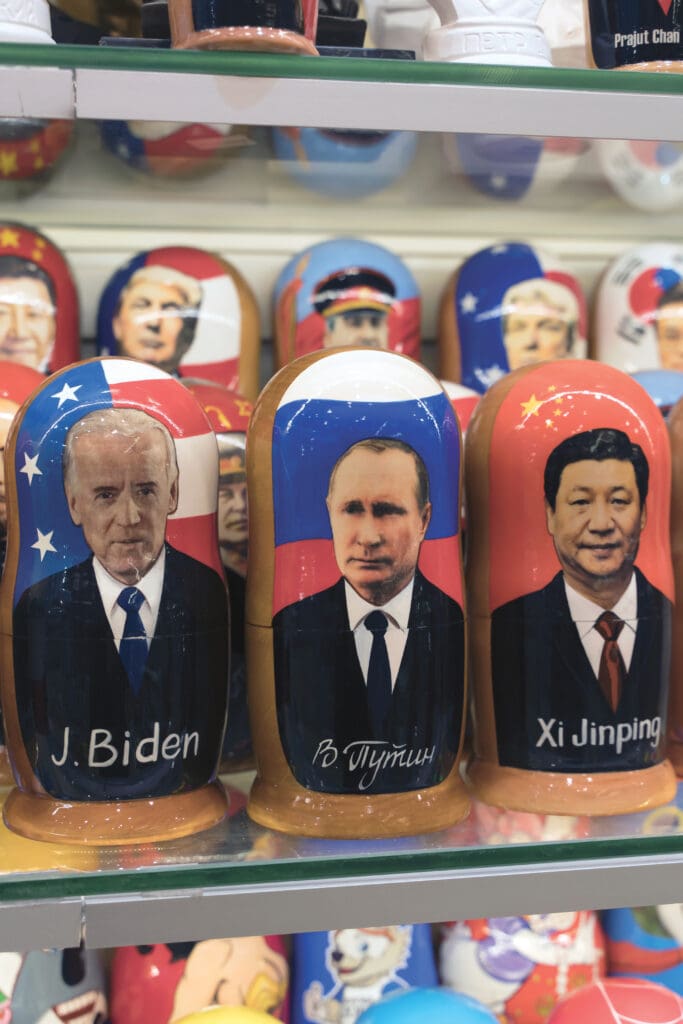
Equally, the Central Asian states are deferential to Chinese interests and the economic pull of China’s Belt and Road investments.14 All these countries, except for Turkmenistan, function within the Shanghai Cooperation Organisation (SCO), which is the world’s largest economic and security cooperation group both by geographical size and population, covering 60 per cent of the Eurasian land mass and 40 per cent of the world’s population.15 The SCO expanded to include India and Pakistan in 2017,16 and Iran in 2023.17 It also maintains dialogue partners from across the rest of Asia and the Middle East, including Saudi Arabia, Türkiye, Egypt, and the UAE.18 This is a major developmental, defence, and security arrangement through which many countries now orbit both China and Russia. In contrast, the states of the Asia-Pacific littoral—Japan, South Korea, and much of Southeast Asia (excluding Cambodia and Myanmar)—are primarily concerned with the implications of the spread of Chinese power and influence in the region, and so naturally tilt towards the Western line, and a so-called ‘axis of democracy’.19
‘What we see in the Indo- Pacific arena are degrees of alignment, where countries exist in a condition of geopolitical ambiguity’
The Russia–Ukraine War merely sharpens the sense of insecurity in relation to the more assertive line that Xi Jinping’s regime promotes to restore China to a position of global pre-eminence.20 The main Indo-Pacific players in the ‘axis of democracy’ therefore wish to offset China’s influence via institutions such as the Quadrilateral Security Dialogue (QUAD). The QUAD comprises Australia, Japan, the US, and India. This diplomatic network seeks to reaffirm—according to its Joint Statement of March 2022—its commitment to an ‘Indo-Pacific, in which the sovereignty and territorial integrity of all states is respected and countries are free from military, economic, and political coercion’.21 All of which can be taken as loosely aimed in the direction of China. Such sentiments broadly accord with the security outlook of most member states of the Association of Southeast Asian Nations (ASEAN), which by degrees of hedging and strategic ambiguity bend toward the West.22
India and the Third Diplomatic Dimension
India is a member of the QUAD and has historically had a fractious relationship with the People’s Republic of China, including several ongoing border disputes that have resulted in armed clashes over the decades. Nevertheless, when it comes to the impact of the Russia–Ukraine War on its foreign policy, India provides some interesting pointers in terms of which way the diplomatic wind might be blowing. India represents a ‘third diplomatic dimension’, as a major regional power. India’s foreign policy is heir to a historical tradition of non-alignment between the superpowers.23 During the Cold War India leant towards the USSR, especially in military procurements, seeking to counter-balance both US and Chinese power.24 Consequently, India does not feel any compulsion to align itself over the Russia–Ukraine War, instead preserving the latitude to lean towards or away from these axes as befits its national interests. This trend has been sharpened in the post-Cold War era in which India increasingly regards itself as a major player in the international system. As a force to be reckoned with, India wishes to chart its own path in world affairs.25
Over the war in Ukraine India’s non-aligned approach has led to tensions with the US and Europe. As India sees it, the West demands that it should take sides against Russia.26 The pushback from India is most forcefully expressed by the country’s Minister for External Affairs, Dr Subrahmanyam Jaishankar, who makes the point that India should not be made to feel that Europe’s problems are its problems. This is especially so when India’s perception is that the West helped create the conditions that led to the Ukraine crisis through its policy of NATO expansion.27 India, and other states, both within and beyond the Indo-Pacific, argue they should not be asked to choose sides, and resent it when they are prevailed upon to do so.28
The Multiple Geopolitical Dynamics in the Indo-Pacific
Thus, what we are witnessing in the Indo-Pacific in the light of the Russia–Ukraine conflict are a set of complex dynamics, both obvious and less obvious. Firstly, and most perceptibly, the Russia–Ukraine War has forced a dividing line among states in the region, causing some states to align with one or other of these geopolitical axes. Beyond those states that are formally allied with—or obviously bound closely to—one or other of the axes (in the West’s case Australia, Japan, and South Korea, or the Central Asian powers with respect to Russia and China), the responses of other states have been more ambiguous.
Much of this ambiguity reflects diplomatic traditions of hedging and non-alignment that one sees across the Indo-Pacific, especially in Southeast Asia.29 However, some of the ambiguity also speaks to a loss of status and prestige and economic clout30 that the collective West has suffered because of the imprudence and hubris embedded within the Western grand strategic project. This has resulted in a grudging, and sometimes not-so-grudging,31 respect for both Russia and China for standing up for their national interests and civilizational codes against what is perceived to be a ‘liberal imperialist’32 crusade that has seen the West meddle in the internal affairs of countries, or intervene directly with military force. The well-known recent examples are of course Afghanistan, Iraq, Libya, and Syria, but now includes Ukraine, which for decades has been the object of interest for Western policymakers, principally as a tool to intrude upon Russian geopolitical sensibilities.33
Several factors are in play here that are acting to weaken the gravitational pull of the West: notably the blow to Western prestige wrought by the chaotic withdrawal from Afghanistan in the summer of 2021 following two decades of futile nation building.34 Other factors include the de-industrialization and economic waning of the West over thirty years caused by neo-liberal economics and the outsourcing of manufacturing capacity to cheaper labour markets elsewhere, and the follies of net-zero and the undermining of energy self-sufficiency.35 Along with the failure of Western financial sanctions against Russia,36 these factors combine to make the West look weak in contrast to the rising and economically and culturally resilient powers of China and Russia. These factors cause nations to look around and entertain options other than to defer to Western/US interests, as they might have felt compelled to do in the past.37
Axis of Democracy or Axis of Hypocrisy?
It is, moreover, the sense of Western double standards that multiplies this alienating effect. The Russian invasion of Ukraine strikes many in the West as an obvious case of aggression. It gets Western governments up in arms about violations of sovereignty and democracy.38 Yet, claim other countries, where were the calls for UN condemnation, sanctions, military intervention, and war crimes trials when it was Western countries that were doing the invading, knocking over regimes, de-stabilizing regions, and inflicting humanitarian suffering on host populations?39
‘We are truly in a New World Order. Just not the one that its “end of history” architects originally envisaged’
It is this enduring perception of Western inconsistency embedded in notions of the ‘liberal international order’ that cause nations to doubt the sincerity of Western commitments to freedom and democracy. Along with the sense that liberal imperialism embodies the promotion of individualistic, self-indulgent lifestyles, and the character of contending grand-strategies visions begins to intimate a clash of civilizations.40 As a result, this putative clash of cultural worldviews causes states to lean towards the axis of autocracy because they do not necessarily see the other side as an axis of democracy, but as an axis of hypocrisy.
You Do Not Have to Be a Strategic Genius
In this respect, Western grand strategy in its liberal crusading posture is deeply flawed in conception and execution. Western policy has, consequently, pursued a particularly inept diplomatic path, especially under the current US administration, because it produces outcomes that are seemingly contradictory to prudential calculations of Western geopolitical interests. For example, one reason why China’s leaders support Russia and will not allow it to be defeated in Ukraine is the fear that if Russia is routed and the regime in Moscow is overthrown, that they will be the next target. This is not delusional thinking on the part of Beijing. It is a goal that has been canvassed openly in circles close to the Washington foreign policy establishment even before Russia’s invasion of Ukraine.41
Therefore, it does not take a strategic genius to work out that such a policy is guaranteed to drive Russia and China—despite their geopolitical differences—to back each other to the hilt.42 A smarter Western foreign policy, as was exercised under the previous Trump administration, would be to remain firm but also to actively engage in dialogue with these regimes, which—if Russia had proceeded to invade Ukraine or if China made moves against Taiwan—could well have offered possibilities to play off China against Russia, or vice versa.43
As it is, the West’s ‘for us or against us’ attitude tends to alienate far more than it attracts, and not just in the Indo-Pacific. Important regional players like Saudi Arabia and Brazil, along with many parts of Africa and the Middle East, are increasingly estranged from what they perceive as Western stridency.44 Furthermore, China has to some extent played a calm diplomatic game.45 Its appeals for negotiations and a settlement in Ukraine,46 in contrast to the West’s advocacy of escalation and open-ended war, strikes many developing countries as far more reasonable.47 Not only does this sound more reasonable, but Russia and China are not threatening regime change or sanctions, or providing economic investment and developmental aid with all sorts of strings attached. Trade, investment, and non-interference look very attractive in contrast to an ideologically fixated, hectoring West—a West, moreover, that appears increasingly internally divided between its neo-liberal globalist elites and its own citizenry.
Conclusion: The Rest Terminating the West?
In consequence, the Russia-Ukraine War clearly intimates an emerging multipolar order. States, and not just those in the Indo-Pacific, look around the world and discern that they have options. It is not necessarily the case that they wish to align themselves overtly with China and Russia. The point is that they do not feel the need to choose sides anymore. We are truly in a New World Order. Just not the one that its ‘end of history’ architects originally envisaged.48
The overarching intent behind Western grand strategy to bend the world towards a so-called liberal international order reached its high point between 1991 and 2001. However, its ideological fixation upon an end-of-history teleology has, in the manner that Walter Russell Mead lamented, ultimately rendered Western leaders incapable of making smart, prudential, geopolitical calculations. Their obsessions have ended up dissipating the West’s economic and military resources and undermined Western prestige and soft power. An evolving international system where a liberal, some might say ‘Woke West’ (or at least the West’s Woke elites), are ranged against more traditional societies of the East and the developing worlds, has profound implications for the global order. One of which is the uncomfortable realization that in the aftermath of the Russia–Ukraine War, it may well be that the world is isolating the West rather than isolating Russia.49
This paper is based on a presentation at The Third Danube Geopolitical Summit (organized by the Danube Institute and The Heritage Foundation in Budapest on 21–22 September 2023).
NOTES
1 Walter Russell Mead, ‘The Return of Geopolitics: The Revenge of the Revisionist Powers’, Foreign Affairs, 93/3 (2014), 69–79.
2 Mead, ‘The Return of Geopolitics’, 69.
3 Mead, ‘The Return of Geopolitics’, 69.
4 Hal Brands, ‘Six Propositions about Great-Power Competition and Revisionism in the 21st Century’, The Future of the Global Order Colloquium (Perry World House, University of Pennsylvania), Fall 2017, 2–4.
5 Razvan Sibii, ‘Grand Strategy’, Britannica, www.britannica.com/topic/grand-strategy, accessed 26 September 2023.
6 See for example Hal Brands, What Good Is Grand Strategy? Power and Purpose in American Statecraft from Harry S. Truman to George W. Bush (Cornell University Press, 2014); John Lewis Gaddis, On Grand Strategy (Penguin/Random House, 2018); Rebecca Friedman Lissner, ‘What Is Grand Strategy? Sweeping a Conceptual Minefield’, Texas National Security Review, 2/1 (2018), 52–73; Thierry Balzacq and Ronald R. Krebs, eds, Oxford Handbook of Grand Strategy (Oxford University Press, 2021). See also Center for Analysis of U.S. Grand Strategy (RAND National Security Research Division), www.rand.org/nsrd/isdp/grand-strategy.html, accessed 26 September 2023.
7 Anthony H. Cordesman, ‘How? (and Does?) the War in Ukraine End: The Need for a Grand Strategy’, Center for Strategic and International Studies (24 February 2023), www.csis.org/analysis/how-and-does-war-ukraine-end-need-grand-strategy. See also ‘U.S. Grand Strategy after Ukraine’, The Business Standard (30 March 2022), www.tbsnews.net/thoughts/us-grand-strategy-after-ukraine-393718; Anders Fogh Rasmussen et al., ‘Revisiting U.S. Grand Strategy after Ukraine’, Foreign Policy (2 September 2022), https://foreignpolicy.com/2022/09/02/us-grand-strategy-ukraine-russia-china-geopolitics-superpower-conflict/.
8 John Bolton, ‘A New American Grand Strategy to Counter Russia and China’, The Wall Street Journal (12 April 2023), www.wsj.com/articles/a-new-american-grand-strategy-to-counter-russia-and-china-asian-nato-aukus-collective-defense-taiwan-da555cf.
9 Jeffrey Sachs, ‘NATO Chief Admits NATO Expansion Was Key to Russian Invasion of Ukraine’, Common Dreams (20 September 2023), www.commondreams.org/opinion/nato-chief-admits-expansion-behind-russian-invasion.
10 ‘Remarks by President Biden on the United Efforts of the Free World to Support the People of Ukraine’, The White House (26 March 2022), www.whitehouse.gov/briefing-room/speeches-remarks/2022/03/26/remarks-by-president-biden-on-the-united-efforts-of-the-free-world-to-support-the-people-of-ukraine/.
11 William A. Galstone, ‘The New Axis of Autocracy’, The Wall Street Journal (8 February 2022), www.wsj.com/articles/axis-autocracy-russia-putin-ukraine-china-france-germany-commit-defense-invasion-scholz-biden-macron-11644336548; Justin Daniels, ‘Putin Has Assembled an Axis of Autocrats against Ukraine’, Foreign Policy (3 March 2023), https://foreignpolicy.com/2023/03/03/putin-russia-china-iran-ukraine-autocrats/.
12 Philip Bump, ‘The Newly Important American Political Axis: Democracy vs. Autocracy’, The Washington Post (18 March 2022), www.washingtonpost.com/politics/2022/03/18/newly-important-american-political-axis-democracy-vs-autocracy/.
13 Eugene Chausovsky, ‘Why Russia Sent Troops into Kazakhstan’, Foreign Policy (7 January 2022), https://foreignpolicy.com/2022/01/07/kazakhstan-russia-troops-csto/.
14 See Aigoul Abdoubaetova, ed., China’s Belt and Road Initiative in Central Asia: Ambitions, Risks and Realities (Special Issue 2) (Bishkek: OSCE Academy/Norwegian Institute of International Affairs, 2020).
15 See Shanghai Cooperation Council, http://eng.sectsco.org/, accessed 27 September 2023.
16 Casey Michael, ‘SCO Set to Expand, Adding India and Pakistan’, The Diplomat (6 June 2017), https://thediplomat.com/2017/06/sco-set-to-expand-adding-india-and-pakistan/, accessed 27 September 2023.
17 Krishn Kaushik and Y. P. Rajesh, ‘SCO Says Not against Any Country as It Expands Reach, Welcomes Iran’, Reuters (4 July 2023), www.reuters.com/world/india/putin-xi-attend-virtual-sco-summit-hosted-by-indias-modi-2023-07-04/.
18 Shanghai Cooperation Organization, ‘New SCO Dialogue Partners’ (5 June 2023), http://eng.sectsco.org/politics/20230506/942021/-New-SCO-dialogue-partners.html.
19 See Sui-Lee Wee, ‘Vietnam and U.S. Forge Deeper Ties as Worries Rise about China’, The New York Times (8 September 2023), www.nytimes.com/2023/09/08/world/asia/biden-vietnam-china.html.
20 ‘President Xi Promises More Assertive Chinese Foreign Policy’, Financial Times (20 March 2018), www.ft.com/content/ad0bda86-2be9-11e8-9b4b-bc4b9f08f381.
21 Prime Minister’s Office, ‘Quad Joint Leaders’ Statement’ (Delhi: Public Information Bureau), 24 March 2022, https://pib.gov.in/PressReleaseIframePage.aspx?PRID=1827892.
22 Andrea Passeri, ‘The Russia–Ukraine War Is ASEAN’s Latest Political Headache’, Australian Outlook, Australian Institute for International Affairs (9 June 2023), www.internationalaffairs.org.au/australianoutlook/the-russia-ukraine-war-is-aseans-latest-political-headache/.
23 P. S. Raghevan, ‘The Making of India’s Foreign Policy: From Non-Alignment to Multi-Alignment’, Indian Foreign Affairs Journal, 12/4 (2017), 326–341.
24 S. Nihal Singh, ‘Why India Goes to Moscow for Arms’, Asian Survey, 24/7 (1984), 707–720.
25 Ashley J. Tellis, ‘India as a Leading Power’, Carnegie Endowment for International Peace (4 April 2016), https://carnegieendowment.org/2016/04/04/india-as-leading-power-pub-63185, accessed 27 September 2023.
26 Vikas Pandey, ‘Ukraine: Why India Is Not Criticising Russia over Invasion’, BBC News (3 March 2022), www.bbc.com/news/world-asia-india-60552273.
27 Roy Barman, ‘Europe Has to Grow Out of Mindset that Its Problems Are World’s Problems: Jaishankar’, Indian Express (4 June 2022), https://indianexpress.com/article/india/europe-has-to-grow-out-of-mindset-that-its-problems-are-worlds-problems-jaishankar-7951895/. See also ‘Europe has to grow out of mindset that Europe’s problems are world’s problems: EAM’, DD India, YouTube, www.youtube.com/watch?v=Av1wcg7h_Tw, accessed 27 September 2023.
28 Marwan Bishara, ‘The World Is United on Ukraine, Divided on America’, Al Jazeera (27 February 2022), www.aljazeera.com/opinions/2022/2/27/the-world-is-united-on-ukraine-divided-on-america.
29 See Chien-peng (C. P.) Chung, ‘Southeast Asia– China Relations: Dialectics of “Hedging” and “Counter-Hedging”’, Southeast Asian Affairs (2004), 35–53; David Martin Jones and Nicole Jenne, ‘Hedging and Grand Strategy in Southeast Asian Foreign Policy’, International Relations of the Asia-Pacific, 22/2 (2022), 205–235.
30 See John Mills, Why the West Is Failing: Failed Economics and the Rise of the East (Polity, 2022).
31 Elliot Smith, ‘“It’s Not a Pretty Picture”: Russia’s Support Is Growing in the Developing World’, CNBC (30 March 2023), www.cnbc.com/2023/03/30/ukraine-war-how-russias-support-is-growing-in-the-developing-world.html; Laurence Norman, ‘West Fails to Peel Russia’s Friends Away to Ukraine’s Side’, The Wall Street Journal (14 September 2023), www.wsj.com/world/u-s-and-europe-struggle-to-win-support-for-ukraine-from-wary-developing-countries-bc853ba3.
32 John J. Mearsheimer, ‘Imperialist by Design’, The National Interest, 111 (January/February 2011), 16–34.
33 Matt Murphy, ‘Ukraine War: US Wants to See a Weakened Russia’, BBC News (25 April 2022), www.bbc.com/news/world-europe-61214176.
34 Carl Bildt, ‘Did the Afghan Failure Lead to the Ukraine War?’, Project Syndicate (16 April 2022), www.project-syndicate.org/commentary/afghanistan-us-failure-set-stage-for-russia-invasion-ukraine-by-carl-bildt-2022-08.
35 Ben Aris, ‘Russia Overtakes Germany to Become Fifth Biggest Economy in the World in GDP on a PPP Basis’, Intellinews (7 August 2023), https://intellinews.com/russia-overtakes-germany-to-become-fifth-biggest-economy-in-the-world-in-gdp-on-a-ppp-basis-286944/.
36 ‘Why the Economic War against Russia Has Failed’, The Spectator (13 May 2023), www.spectator.co.uk/article/why-the-economic-war-against-russia-has-failed/.
37 See Ahmed, ‘China and Russia Are Proposing a New Authoritarian Playbook: MENA Leaders Are Watching Closely’, Atlantic Council (23 February 2023), www.atlanticcouncil.org/blogs/menasource/china-and-russia-are-proposing-a-new-authoritarian-playbook-mena-leaders-are-watching-closely/.
38 Lars Hänsel and Christine Catherine Krause, ‘Russia’s War of Aggression against Ukraine’, Konrad Adenauer Stiftung (2022), www.kas.de/en/russian-war-of-aggression-on-ukraine.
39 See for example Taras Kuzio, ‘War, Peace, and Western Double-Standards: Ukraine and Azerbaijan Compared’, Geopolitical Monitor (26 January 2023), www.geopoliticalmonitor.com/war-peace-and-western-double-standards-ukraine-and-azerbaijan-compared/; Francis Ghilès, ‘Global South Does Not Buy Western Stance on Ukraine’, CIDOB (May 2023), www.cidob.org/es/publicaciones/serie_de_publicacion/opinion_cidob/2023/global_south_does_not_buy_western_stance_on_ukraine.
40 Damon Linker, ‘Is the Russia–Ukraine War a “Clash of Civilizations”?’, The Week (30 March 2022), https://theweek.com/world/1011957/is-the-russia-ukraine-war-a-clash-of-civilizations.
41 See A. Wess Mitchell, ‘A Strategy for Avoiding a Two-Front War’, The National Interest (21 August 2021), https://nationalinterest.org/feature/strategy-avoiding-two-front-war-192137.
42 See Holly Ellyat, ‘Russia and China Are Being Driven Together as the Chasm with the West Deepens’, CNBC (21 March 2023), www.cnbc.com/2023/03/21/russia-and-china-are-becoming-ever-closer-and-the-west-should-worry.html; Alain Franchon, ‘Russia and China are United in an Ideological Battle against the West, and Therefore against Europe’, Le Monde (13 April 2023), www.lemonde.fr/en/opinion/article/2023/04/13/russia-and-china-are-united-in-an-ideological-battle-against-the-west-and-therefore-against-europe_6022835_23.html.
43 Robert D. Blackwill, ‘Trump’s Foreign Policies Are Far Better Than They Seem’, Council on Foreign Relations, Council Special Report No. 84 (April 2019), 8–38.
44 See ‘Brazil Scolds U.S.-Led West at Ukraine Peace Summit in Saudi; “Real Talks Not without Russia”,’ Hindustan Times (August 2023), YouTube, https://www.youtube.com/watch?v=tnF5WlVqqlQ, accessed 29 September 2023.
45 Marco Carnelos, ‘Russian Resilience, US Overconfidence and Chinese Calm: The West Versus the Rest’, Middle East Eye (9 December 2022), www.middleeasteye.net/opinion/uae-russian-resilience-us-overconfidence-chinese-calm-west-versus-rest.
46 See for example: Peter Dickinson, ‘Russia’s Aggression against Ukraine Leaves No Room for Negotiations’, Euronews (24 July 2023), www.euronews.com/2023/07/24/russias-aggression-against-ukraine-leaves-no-room-for-negotiations.
47 Nectar Gan and Simone McCarthy, ‘China Aalls for Russia–Ukraine Ceasefire as Claims to Neutrality Questioned’, CNN (24 February 2023), https://edition.cnn.com/2023/02/23/china/china-position-political-settlement-ukraine-intl-hnk/index.html.
48 Stefan Lehne, ‘After Russia’s War against Ukraine: What Kind of World Order?’, Carnegie Europe (28 February 2023), https://carnegieeurope.eu/2023/02/28/after-russia-s-war-against-ukraine-what-kind-of-world-order-pub-89130.
49 Hans Kundnani, ‘The War in Ukraine, Democracy, and the Global South: We Have a Problem’, International Centre for Defence and Security (Rahvusvaheline Kaitseuuringute Keskus, Estonia) (23 May 2023), https://icds.ee/en/the-war-in-ukraine-democracy-and-the-global-south-we-have-a-problem/.
Read more about the topics of the Third Danube Institute Geopolitical Summit:

